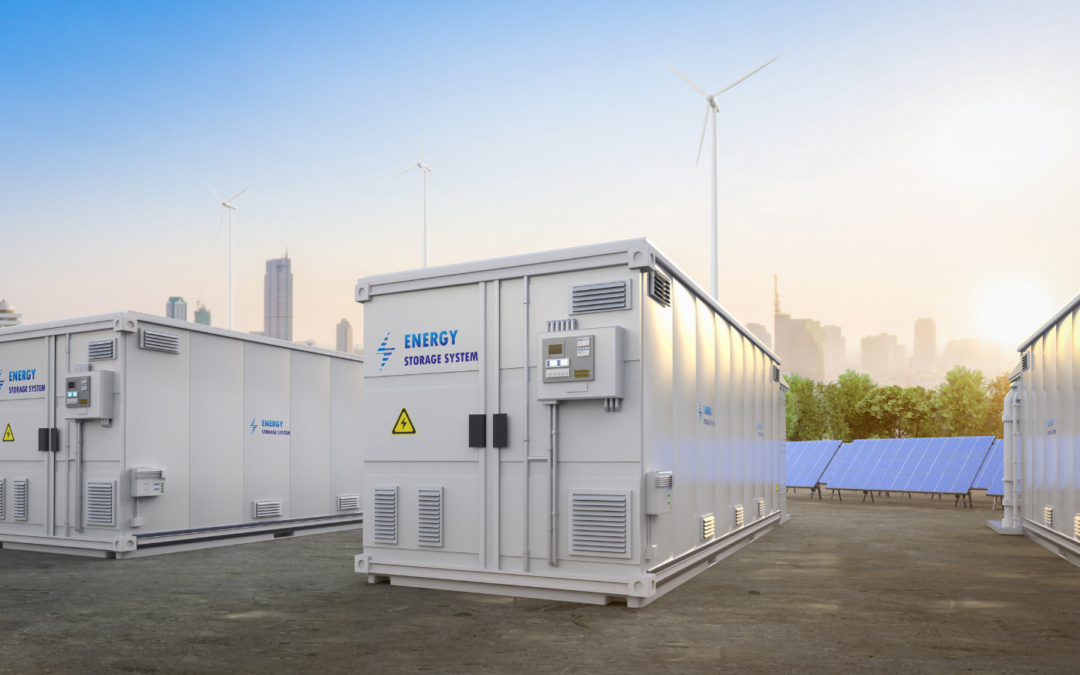Energy provision in the UK is changing fast, with the government hoping to see 95% of our energy coming from low-carbon, mainly renewable sources by 2030. Many shifts in practice and technology will be involved in that change, but one crucial area is perhaps lower in profile than it should be – battery energy storage.
What are Battery Energy Storage Systems?
Battery energy storage systems (BESS) are rechargeable batteries that store energy, from different sources, and then discharge it when it is needed. Consisting of one, or more often a network of batteries, BESS are used to provide backup power, but also within the electric grid system, in cases where the energy produced isn’t needed in the moment.
The current technology is overwhelmingly the lithium-ion battery, familiar from electric vehicles and mobile phones. Lithium extraction can cause environmental and health hazards, so other technologies are being further developed. These include:
- Flow batteries, which can be used as rechargeable fuel cells
- Gravity batteries, in which the energy available is used to lift a mass, for example, water that will later be released to turn a turbine
- Compressed-air energy storage, where energy is used to compress air, with release again forcing a turbine to turn
- Hydrogen energy storage, in which the electrolysis of water is used to make hydrogen, a fuel that can be used later in a combustion engine or fuel cell
Why does BESS matter so much to sustainability?
While some renewable sources such as geothermal are continuous, the majority including Solar PV and Wind Farms, fluctuate in output depending on conditions, sunshine, wind etc. Consumer demand for energy also fluctuates, both in a single day and across the year. Power produced overnight may not be needed until peak hours, and ideally, power produced in summer will be stored until peak winter months. Evening out this volatility, or time-shifting energy produced so that it is available when needed, is a core challenge in renewable energy supply.
Managing the difference between supply and demand is where BESS play a critical part in a renewable energy system, balancing the electric grid, providing backup power, and improving grid stability.
Battery energy storage also has the potential to reduce energy bills. The UK has the world’s largest installed capacity of offshore wind but must often pay for energy at moments of high demand, which comes at a cost financially and environmentally if the extra energy is from fossil fuels. The government has estimated that increased use of innovative technologies, in particular investment in battery storage, could save us £40 billion by 2050.
What is involved in delivering this in practice?
“The requirements are quite consistent in BESS projects,” comments WCS Managing Director Asa Whitfield. “These facilities are large, and require a flat surface, sometimes stepped if necessary, so work to survey and prepare the ground is key. Drainage is a complex area, with the potential for pollution meaning runoff must be appropriately managed to prevent contamination. Rainwater will accumulate too, so the overall anticipated runoff must be dealt utilising principles consistent with sustainable drainage design. In some cases, water is repurposed as a reservoir for firefighters to use if needed. And fire barriers will be needed between batteries or groups of batteries.”
A substation is going to be present where power is moved between the grid and battery storage. For us at WCS, substation projects are an extremely familiar challenge. Whether the facility is needed in relation to BESS – or to take power from the world’s biggest offshore wind farm; to connect a new community such as Welborne Garden Village, where heating and hot water will be delivered by an innovative ambient heat network; or for the equally innovative SELCHP project where energy derived from unrecyclable waste is used to power fleet that collects it; substation projects are a specialisation we approach with confidence borne of experience.
All of those examples given also, of course, centre on sustainability. We write about this topic so often because we are passionate about it, working with clients to help them deliver the infrastructure, which is supporting the UK’s drive towards net zero in the future.
What else might be pivotal to sustainable energy systems?
Traditional energy supply centres on one-way systems, where large and usually remote generation facilities steadily create and distribute power. In today’s world, any building might have solar panels on the roof, giving them the potential to sell energy back to the grid. This is placing new demands on infrastructure but is also an opportunity for a more diversified smart energy network.
In the future energy storage, as well as generation, may involve distributed and local solutions. Bi-directional chargers for electric vehicles are currently a rarity but will expand in use. These allow the energy stored in a car battery to be sent outwards as well as inwards. An EV could charge up in off-peak hours, and then either be used for driving or else selling energy back in peak time or reusing it directly in the home.
Many other innovations are being explored. Together, they will cause us to reassess and reimplement many aspects of our power generation system. The challenges are clear, but the potential for positive change is exciting and vital.
If you would like to discuss a BESS or other electrical project, please get in touch by emailing info@wcs-consult.co.uk or calling +44(0)20 3581 7847.

